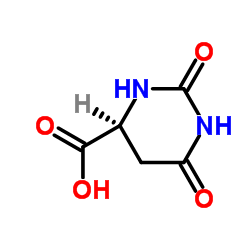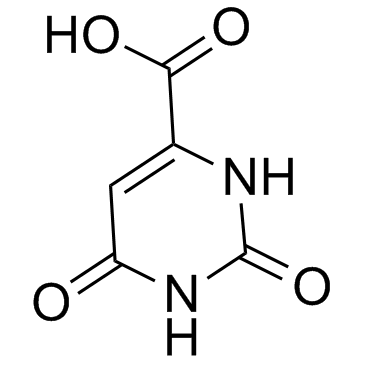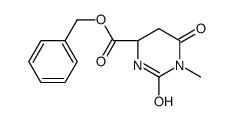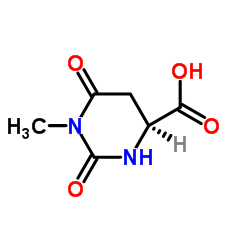L-Dihydroorotic acid

L-Dihydroorotic acid structure
|
Common Name | L-Dihydroorotic acid | ||
|---|---|---|---|---|
| CAS Number | 5988-19-2 | Molecular Weight | 158.112 | |
| Density | 1.9±0.1 g/cm3 | Boiling Point | 524.0±60.0 °C at 760 mmHg | |
| Molecular Formula | C5H6N2O4 | Melting Point | 254-255 °C (dec.)(lit.) | |
| MSDS | Chinese USA | Flash Point | 270.7±32.9 °C | |
| Symbol |

GHS07 |
Signal Word | Warning | |
Use of L-Dihydroorotic acidL-Dihydroorotic acid can reversibly hydrolyze to yield the acyclic L-ureidosuccinic acid by dihydrowhey enzyme[1]. |
| Name | (S)-dihydroorotic acid |
|---|---|
| Synonym | More Synonyms |
| Description | L-Dihydroorotic acid can reversibly hydrolyze to yield the acyclic L-ureidosuccinic acid by dihydrowhey enzyme[1]. |
|---|---|
| Related Catalog | |
| Target |
Human Endogenous Metabolite |
| References |
| Density | 1.9±0.1 g/cm3 |
|---|---|
| Boiling Point | 524.0±60.0 °C at 760 mmHg |
| Melting Point | 254-255 °C (dec.)(lit.) |
| Molecular Formula | C5H6N2O4 |
| Molecular Weight | 158.112 |
| Flash Point | 270.7±32.9 °C |
| Exact Mass | 158.032761 |
| PSA | 95.50000 |
| LogP | -2.29 |
| Vapour Pressure | 0.0±3.1 mmHg at 25°C |
| Index of Refraction | 1.714 |
| InChIKey | UFIVEPVSAGBUSI-REOHCLBHSA-N |
| SMILES | O=C1CC(C(=O)O)NC(=O)N1 |
| Storage condition | Store at 0-5°C |
|
Material Safety Data Sheet
Section1. Identification of the substance L-Dihydroorotic acid Product Name: Synonyms: Section2. Hazards identification Harmful by inhalation, in contact with skin, and if swallowed.
H315:Causes skin irritation H319:Causes serious eye irritation H335:May cause respiratory irritation P261:Avoid breathing dust/fume/gas/mist/vapours/spray P305+P351+P338: IF IN EYES: Rinse cautiously with water for several minutes. Remove contact lenses if present and easy to do – continue rinsing P302+P352:IF ON SKIN: Wash with soap and water P321:Specific treatment (see on this label) P405:Store locked up Section3. Composition/information on ingredients. L-Dihydroorotic acid Ingredient name: CAS number:5988-19-2 Section4. First aid measures Immediately wash skin with copious amounts of water for at least 15 minutes while removing Skin contact: contaminated clothing and shoes. If irritation persists, seek medical attention. Eye contact:Immediately wash skin with copious amounts of water for at least 15 minutes. Assure adequate flushing of the eyes by separating the eyelids with fingers. If irritation persists, seek medical attention. Inhalation:Remove to fresh air. In severe cases or if symptoms persist, seek medical attention. Wash out mouth with copious amounts of water for at least 15 minutes. Seek medical attention. Ingestion: Section5. Fire fighting measures In the event of a fire involving this material, alone or in combination with other materials, use dry powder or carbon dioxide extinguishers. Protective clothing and self-contained breathing apparatus should be worn. Section6. Accidental release measures Personal precautions: Wear suitable personal protective equipment which performs satisfactorily and meets local/state/national standards. Respiratory precaution:Wear approved mask/respirator Hand precaution:Wear suitable gloves/gauntlets Skin protection:Wear suitable protective clothing Eye protection:Wear suitable eye protection Methods for cleaning up: Mix with sand or similar inert absorbent material, sweep up and keep in a tightly closed container for disposal. See section 12. Environmental precautions: Do not allow material to enter drains or water courses. Section7. Handling and storage Handling:This product should be handled only by, or under the close supervision of, those properly qualified in the handling and use of potentially hazardous chemicals, who should take into account the fire, health and chemical hazard data given on this sheet. Storage:Store in closed vessels. Section8. Exposure Controls / Personal protection Engineering Controls: Use only in a chemical fume hood. Personal protective equipment: Wear laboratory clothing, chemical-resistant gloves and safety goggles. General hydiene measures: Wash thoroughly after handling. Wash contaminated clothing before reuse. Section9. Physical and chemical properties Not specified Appearance: Boiling point:No data Melting point:No data Flash point:No data Density:No data Molecular formula:C5H6N2O4 Molecular weight:158.1 Section10. Stability and reactivity Conditions to avoid: Heat, flames and sparks. Materials to avoid: Oxidizing agents. Possible hazardous combustion products: Carbon monoxide, nitrogen oxides. Section11. Toxicological information No data. Section12. Ecological information No data. Section13. Disposal consideration Arrange disposal as special waste, by licensed disposal company, in consultation with local waste disposal authority, in accordance with national and regional regulations. Section14. Transportation information Non-harzardous for air and ground transportation. Section15. Regulatory information No chemicals in this material are subject to the reporting requirements of SARA Title III, Section 302, or have known CAS numbers that exceed the threshold reporting levels established by SARA Title III, Section 313. SECTION 16 - ADDITIONAL INFORMATION N/A |
| Symbol |

GHS07 |
|---|---|
| Signal Word | Warning |
| Hazard Statements | H315-H319-H335 |
| Precautionary Statements | P261-P305 + P351 + P338 |
| Personal Protective Equipment | dust mask type N95 (US);Eyeshields;Gloves |
| Hazard Codes | Xi:Irritant |
| Risk Phrases | R36/37/38 |
| Safety Phrases | S26-S36 |
| RIDADR | NONH for all modes of transport |
| WGK Germany | 3 |
| HS Code | 2934999001 |
| HS Code | 2934999001 |
|---|
|
SEC-TID: A Label-Free Method for Small-Molecule Target Identification.
J. Biomol. Screen. 19(6) , 917-927, (2014) Bioactive small molecules are an invaluable source of therapeutics and chemical probes for exploring biological pathways. Yet, significant hurdles in drug discovery often come from lacking a comprehen... |
|
|
The structures of human dihydroorotate dehydrogenase with and without inhibitor reveal conformational flexibility in the inhibitor and substrate binding sites.
Biochemistry 47(34) , 8929-36, (2008) Inhibitors of dihydroorotate dehydrogenase (DHODH) have been suggested for the treatment of rheumatoid arthritis, psoriasis, autoimmune diseases, Plasmodium, and bacterial and fungal infections. Here ... |
|
|
Miller (Genee-Wiedemann) syndrome represents a clinically and biochemically distinct subgroup of postaxial acrofacial dysostosis associated with partial deficiency of DHODH.
Hum. Mol. Genet. 21(18) , 3969-83, (2012) Biallelic mutations in the gene encoding DHOdehase [dihydroorotate dehydrogenase (DHODH)], an enzyme required for de novo pyrimidine biosynthesis, have been identified as the cause of Miller (Genée-We... |
| (S)-dihydroorotic acid |
| dihydroorotate |
| MFCD00085339 |
| (S)-2,6-Dioxohexahydro-4-pyrimidinecarboxylic acid |
| (S)-2,6-dioxo-hexahydro-pyrimidine-4-carboxylic acid |
| 4-Pyrimidinecarboxylic acid, 4,5-dihydro-2,6-dihydroxy-, (4S)- |
| (4S)-2,6-Dioxohexahydropyrimidine-4-carboxylic acid |
| (4S)-2,6-Dihydroxy-4,5-dihydro-4-pyrimidinecarboxylic acid |
| L-Dihydroorotic Acid |
| (4S)-2,6-Dioxohexahydro-4-pyrimidinecarboxylic acid |
| EINECS 204-352-8 |
| 4-Pyrimidinecarboxylic acid, hexahydro-2,6-dioxo-, (4S)- |
 CAS#:65-86-1
CAS#:65-86-1 CAS#:103300-85-2
CAS#:103300-85-2 CAS#:103365-69-1
CAS#:103365-69-1 CAS#:103300-84-1
CAS#:103300-84-1
